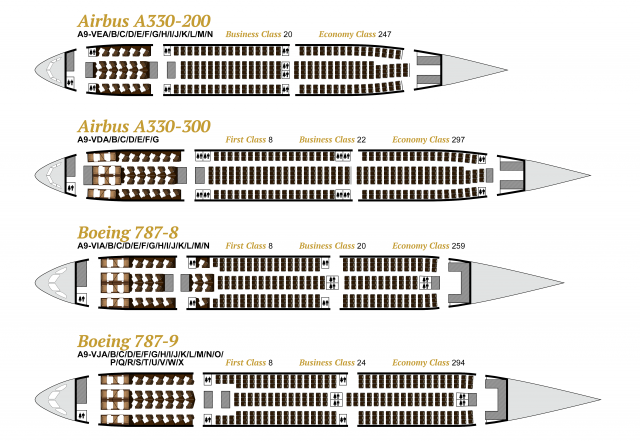Widebody Seat Maps | 2014
- Owner: POTKC (View all images and albums)
- Uploaded: Dec 09 2019 06:41 PM
- Views: 1,654
- Album Kingdom of Dhahran
All 15.3 million pixels © POTKC 2019, reproduction or use not permitted without written and explicit consent.

This next installment of Dhahrani seatmaps shows the 'smaller' widebodies in the fleet in 2014. This was the year that the 787-9s began entering the fleet, an at this point in time most of the A330s operated by Dhahrani had already been reconfigured to the new interior hard product. Not shown here are the 777-300ERs (which would finish being reconfigured in 2016), the A340-600 (which was not reconfigured before its retirement in 2017) or the A340-300 (which was retired towards the end of 2014). From top to bottom of this seatmap image:
First comes the A330-200, of which there were fourteen in the fleet at the time. Despite previously having First Class, all fourteen were reconfigured into a two-class configuration when the new hard product was installed, featuring 20 Business Class seats and 247 in Economy. The product selected for use in Dhahrani's new Business Class was the B/E Aerospace Super Diamon reverse-herringbone seat, arranged in a 1-2-1 setup offering direct aisle access from every seat - a first for the airline. High-quality Italian leather upholstery and wood panelling was used to give the seats a dark and luxurious feel, with rectangular marble drink-supports added to the side console next to each seat to provide a splash of brightness. These marble elements became the trademark element of Dhahrani premium seating. The A330-200 was configured without First Class as it was placed specifically on shorter routes to Europe and within the Middle East (for example, from 2014 onwards five out of the seven daily rotations to Dubai were operated by the A330-200), which did not warrant the inclusion of First Class service.
The A330-300 is next, shown here specifically fitted with First Class. Around half of the -300s in the fleet were in a two-class config like the -200s, however the other half, A9-VDA through -VDG, were configured with First. This was a version of the First Class introduced on the 787 which was slightly miniaturized to fit the A330's narrower fuselage, and the details of it will be discussed further down in this commentary, for now it suffices to say that the A330-300s were configured with eight First Class suites in a 1-2-1 configuration, 22 Business Class seats, and 297 in Economy. Following the introduction of the 787, the A330-300s were flown on a variety of medium-to-long-haul routes, however usually towards the shorter end. This is because they (especially in the configuration featuring First Class) have a very similar capacity to the 787-9, however are much less efficient on long routes.
The 787-8, introduced into the fleet in 2012, was the first aircraft to feature the new hard product, being outfitted with eight First Class suites, 20 Business, and 259 Economy. The new First Class first brought into service on the 787, then retrofitted to the A330-300s and 777s in the fleet, is comprised of forwards-backwards facing paired suites, with the rear-facing one in each pair featuring a slightly longer bed. The seat pairs make use of a clever angled divider to increase the space available to each passenger while decreasing the floor area used. Electronic controls for the seat, lighting, window shades, and entertainment system are all located on the aisle side of the suite, and the table is stowed in the console on the other side, which also has storage space. The triangle-shaped ottoman can be used by another passenger to dine together. Each seat is 23.6" wide, and converts into a 33" wide bed by reclining and folding the leather armrests up into the seat back. Each First Class suite is fully enclosed by a sliding door, and naturally features a larger version of the marble drinks table found in Business.
Finally, the 787-9 - introduced into the fleet in 2014 - is configured with the same hard product in all classes, featuring 8 First Class suites, 24 Business class seats, and 294 seats in Economy. With its impressive range and balanced seating configuration, the 787-9 is used on everything from high-premium-demand European routes like London Heathrow to long-haul ones to Washington DC, Miami, and Sydney, as well as shorter regional flights (for example to Riyadh) in the downtime between long rotations.
Disclaimer: This project is designed to look at the progression of aviation in a more-or-less generic fictional Middle Eastern state. The fictional Kingdom of Dhahran is located near the real Saudi Arabian city called Dhahran, but has no affiliation with it, and the name is a coincidence. Any other similarities to real people, locations, or situations may be intentional. I have zero knowledge of Arabic, so while I have spent considerable time trying to get it right, mistakes are possible, and any advice is greatly appreciated.

 Sign In
Sign In Create Account
Create Account










